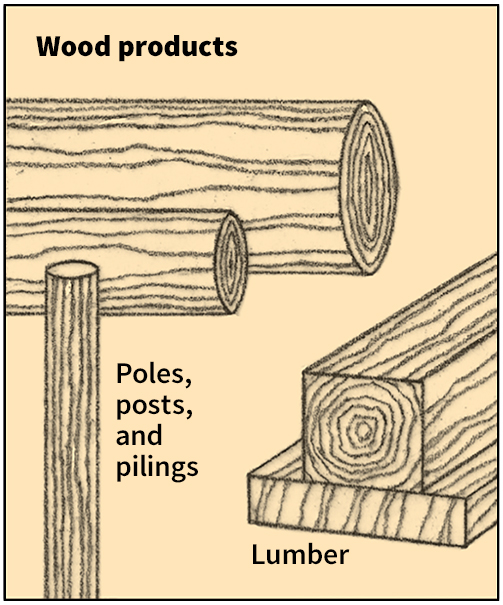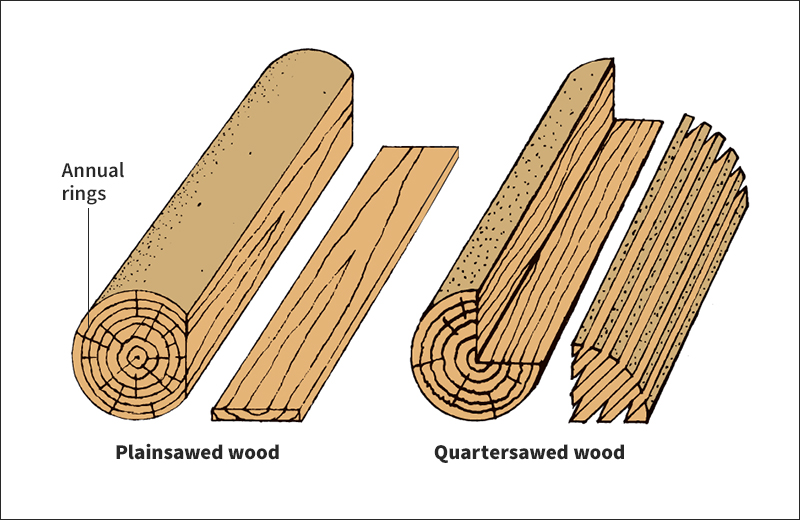Wood is a tough substance under the bark of trees, shrubs, and certain other plants. The physical properties of wood, plus its chemical composition, make it one of the most valuable natural resources. Wood is used in making thousands of products, including baseball bats, charcoal, furniture, lumber, musical instruments, paper, plywood, railroad ties, and rayon.
Wood’s physical properties make it especially useful for construction work. It is tough, strong, and easy to handle. Wood also insulates well, does not rust, and resists high heat better than steel. However, wood shrinks and swells, depending on how much moisture it loses or absorbs. Every piece of wood has a distinctive—and different—pattern called the figure. The figure is a highly desirable feature of wood used for furniture, cabinets, and other fine wood products.

This article discusses the physical and chemical properties of wood. For additional information on wood and its many uses, see the World Book articles on Forest products, Lumber, and Tree.
Kinds of wood.
There are two general kinds of wood, softwood and hardwood. These terms refer to the type of tree from which wood comes. They do not necessarily indicate the hardness of wood.
Softwood comes from cone-bearing trees, called conifers. Most conifers have needlelike, evergreen leaves. Common softwoods include cedar, Douglas-fir, hemlock, pine, redwood, and spruce. They can be easily sawed, planed, chiseled, and bored, and so they are good for construction purposes. They also supply most of the pulpwood used to make paper products.
Hardwood comes from broad-leaved trees. Most of these trees are deciduous—that is, they lose their leaves every autumn. Birch, elm, mahogany, maple, and oak are common hardwoods. Their rich and distinctive figures add to the beauty of furniture, paneling, and floors.
The composition of wood.
Wood consists of tiny, tube-shaped cells that form layers of permanent tissue around a plant stem. The walls of wood cells are made of three chief substances—cellulose, lignin, and hemicellulose. Cellulose makes up about half of wood by weight. It is soft and consists of fibers. Cotton, for example, contains more than 95 percent cellulose. Lignin, on the other hand, is a heavy, solid material that is found between strands of cellulose and between the wood cells themselves. Lignin makes wood hard and stiff. Hemicellulose helps to hold cellulose strands together. Wood also contains substances called extractives. They include fats, gums, oils, and coloring matter.

The proportion of cellulose, lignin, hemicellulose, and extractives varies among different kinds of wood. The cellular structure also differs. These variations make some wood heavy and some light, some stiff and some flexible, and some plain and some colorful.
Manufacturers obtain useful chemicals and by-products from wood. These products include animal feeds, adhesives, lacquers, turpentine, plastics, photographic film, rayon, and artificial vanilla. Chemicals obtained from wood are used to give special properties to various materials, including explosives and concrete.
Wood figure
is determined chiefly by the growth process of the tree. It results from combinations of color, luster, texture, and grain.
The color comes mainly from extractives. Uneven distribution of the extractives produces a pigment figure, found especially in ebony, rosewood, and walnut. Luster is the way wood reflects light. Many woods, including birch and pearwood, require a coat of varnish or another clear finish to bring out their luster. The texture of wood results from the structure of the cells. For example, beech, satinwood, and sycamore have small, closely spaced cells, which produce a fine texture. Other woods, such as oak, ash, and elm, contain groups of large cells called vessels that produce areas of coarse texture and interesting patterns. The grain depends on the arrangement and direction of the cells. The figure is also determined by the way wood is sawed. There are two ways of cutting wood, plainsawing and quartersawing. Plainsawing produces oval and curved figures. Quartersawing gives wood a striped appearance.
In some woods, the figure depends on the part of the tree from which the wood is cut. Tree stumps and wartlike outgrowths called burls have attractive patterns. The most popular stumpwood is American walnut. Cherry and walnut have highly prized burls.
